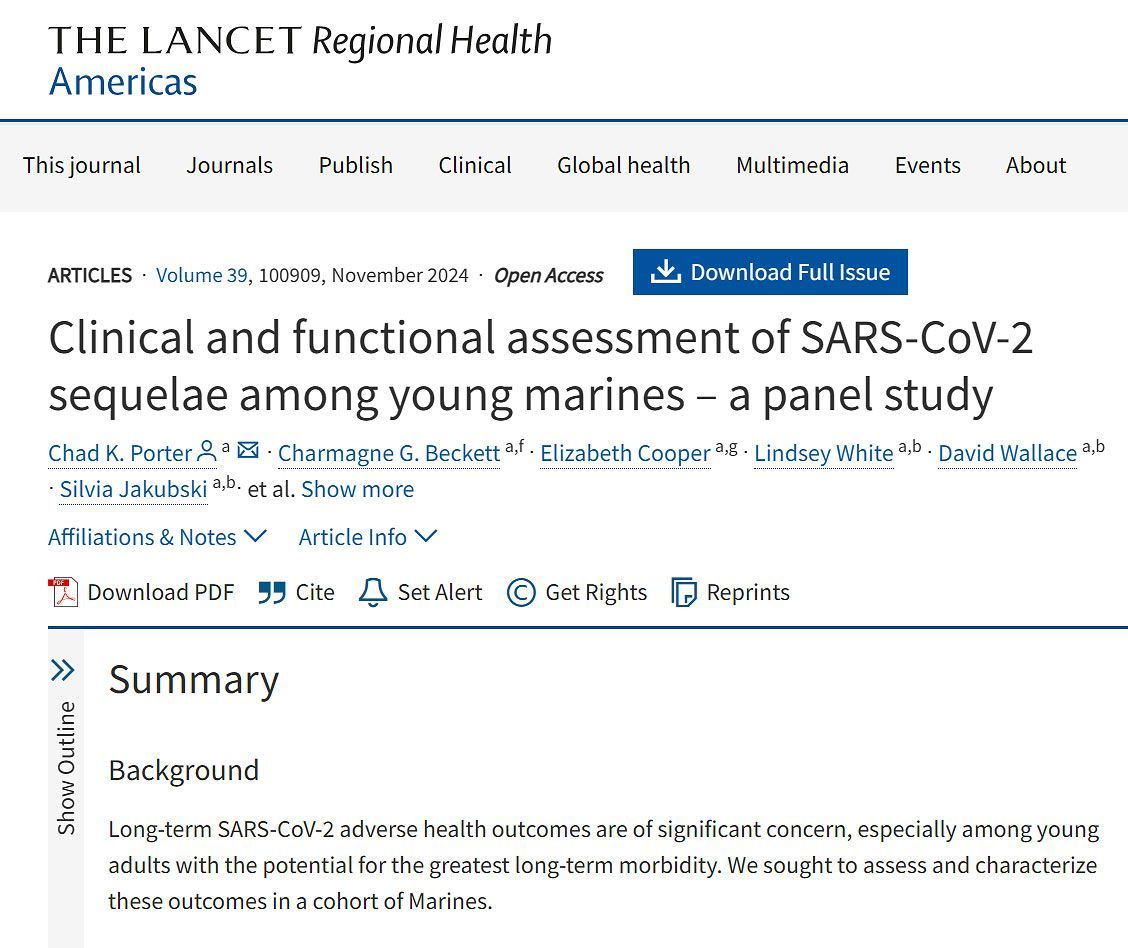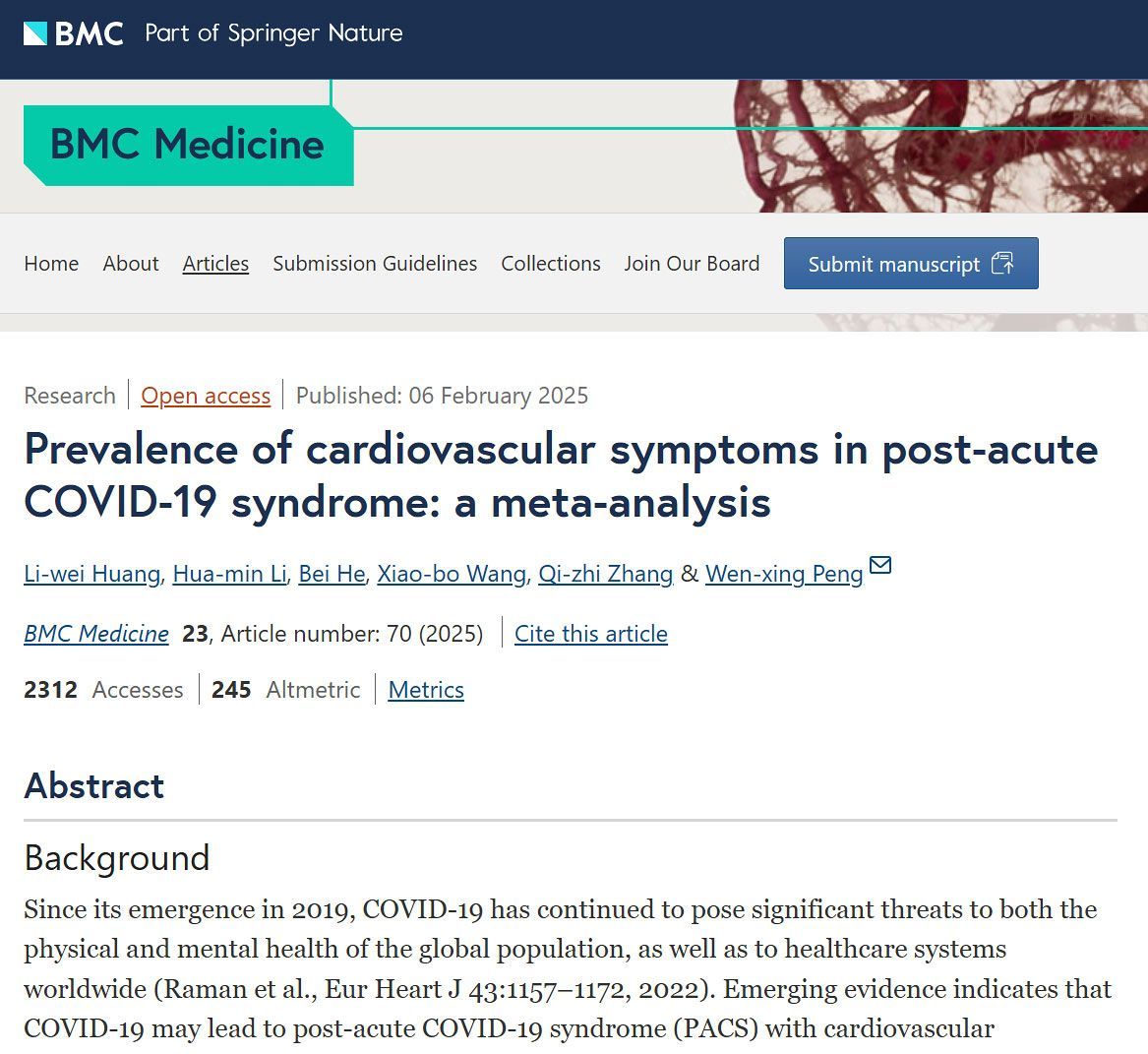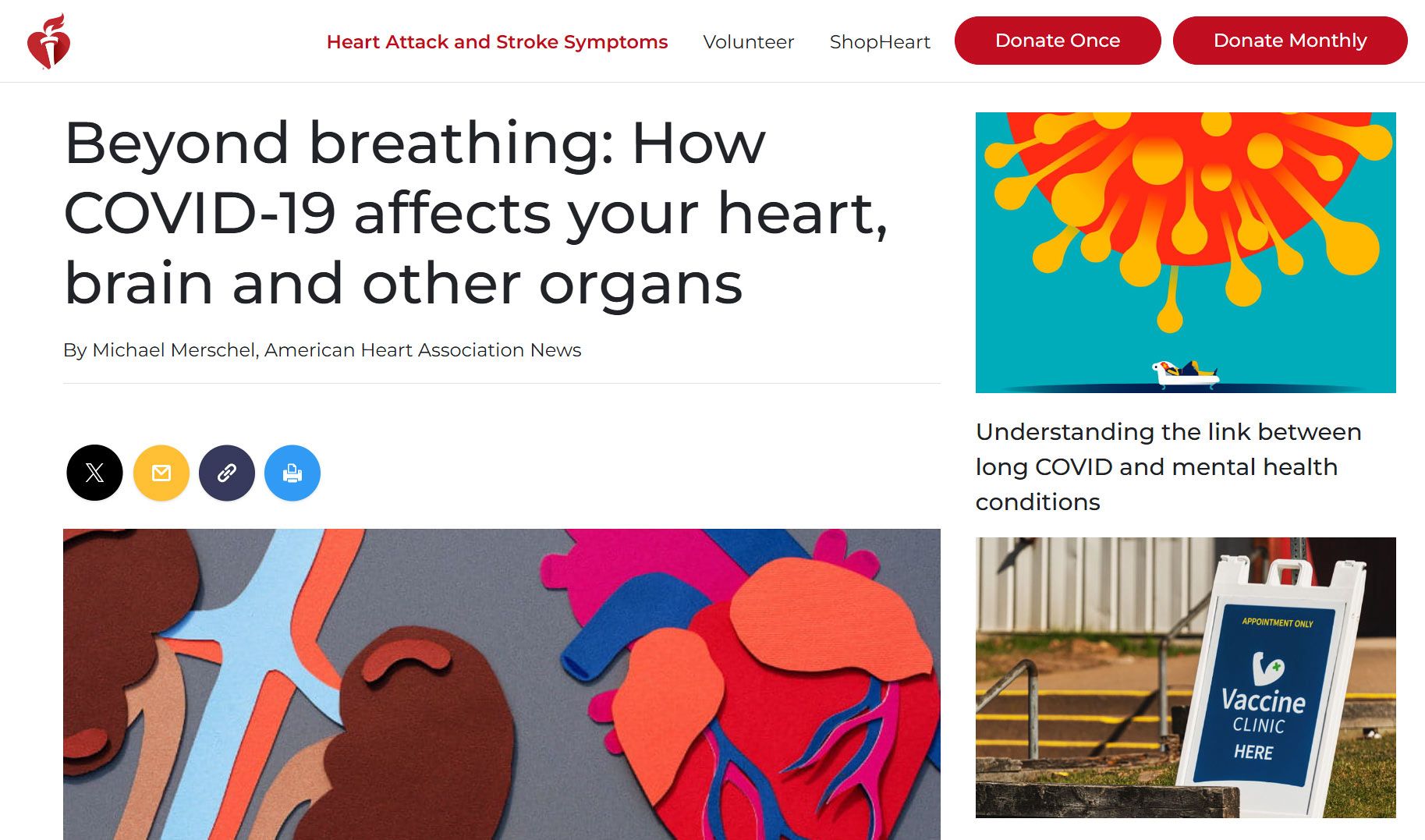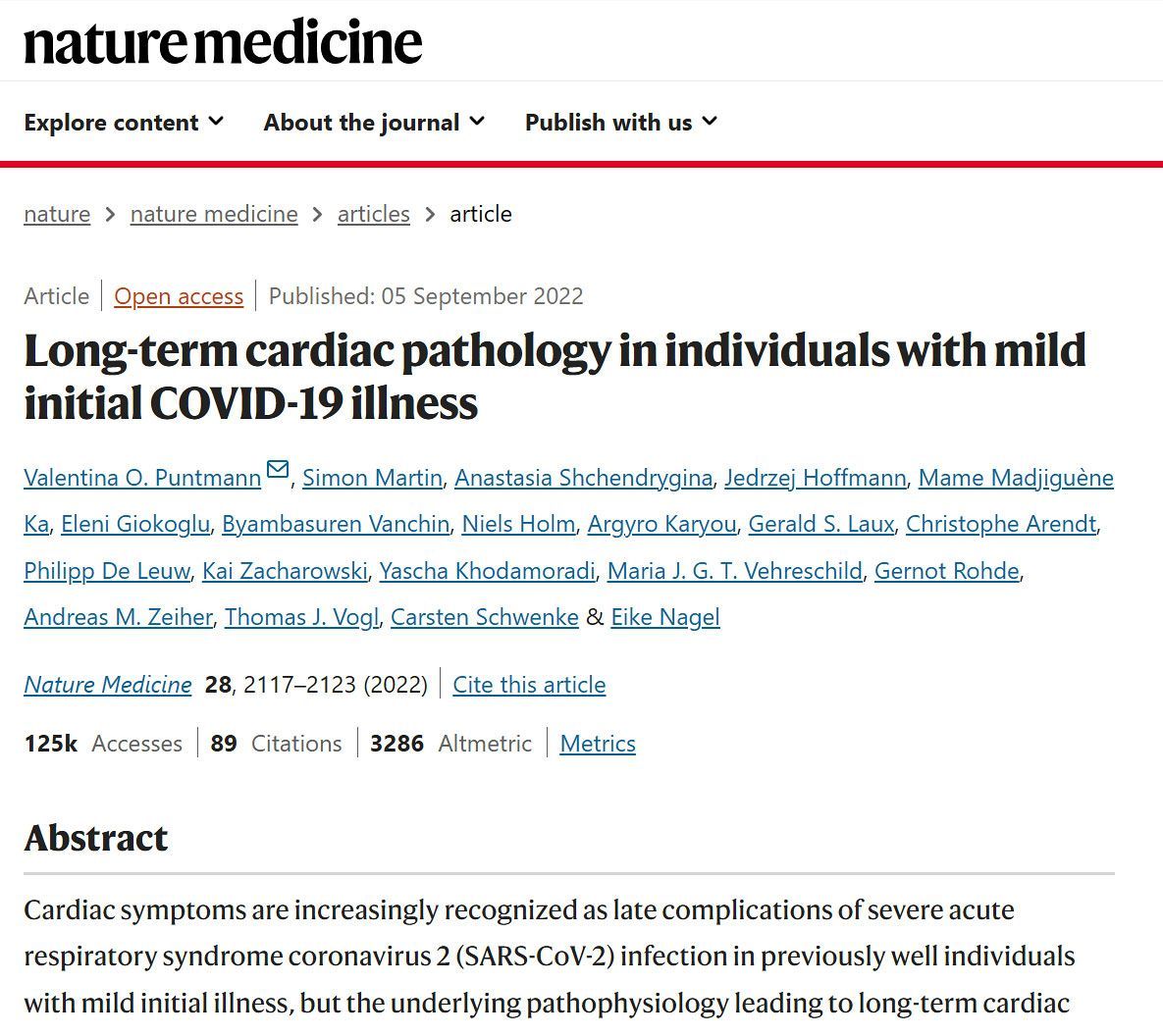on the heart
‘SARS-CoV-2, the virus that causes COVID-19, can directly infect the arteries of the heart and cause the fatty plaque inside arteries to become highly inflamed, increasing the risk of heart attack and stroke.’
National Institutes of Health (NIH/USA) (2023) ➤
❦ one from the heart
“If you’re an MD [doctor] that spends time counseling patients to exercise and quit smoking in order to reduce their risk of a heart attack or stroke, and you haven’t yet added “avoid COVID” to your ‘cardiovascular risk factors’ counseling speech – you may want to re-evaluate that oversight.”
Dr. Lisa Iannattone (2023) ➤
❦ the heart & circulation ~ further reading
C-19 Archives:
heart













❦ on the heart: scientific papers & media articles
✒ 2023
📖 (31 Aug 2023 ~ Science)
Clotting proteins linked to Long Covid's brain fog ➤
❂
📖 (June 2023 ~ Cardiovascular Research) Association of COVID-19 with short- and long-term risk of cardiovascular disease and mortality: a prospective cohort in UK Biobank ➤
❂
📖 (12 May 2023 ~ The British Heart Foundation) Is coronavirus a disease of the blood vessels? ➤
❂
📖 (19 Apr 2023 ~ Annals of Hematology) Status of major hemostatic components in the setting of COVID-19: the effect on endothelium, platelets, coagulation factors, fibrinolytic system, and complement ➤
➲ 'COVID-19 patients have a hypercoagulability state, and thrombosis is a life-threatening complication of them.'
Hypercoagulability, also known as thrombophilia, is a condition in which there is an abnormally increased tendency towards blood clotting.
❂
📖 (10 Mar 2023 ~ Current Cardiology Reports) How Does COVID-19 Affect the Heart? ➤
❂
📖 (5 Mar 2023 ~ Boston Herald) Long COVID linked to increased risk for heart disease ➤
❂
📖 (18 Apr 2023 ~ International Journal of Molecular Sciences) Human Endogenous Retrovirus, SARS-CoV-2, and HIV Promote PAH via Inflammation and Growth Stimulation ➤
➲ 'Pulmonary arterial hypertension (PAH) is a pulmonary vascular disease characterized by the progressive elevation of pulmonary arterial pressures.'
Pulmonary Arterial Hypertension (PAH) is a progressive lung disease that affects the heart and lungs.
It is caused when the tiny arteries in the lungs become thickened and narrowed, causing abnormally high blood pressure in the pulmonary artery.
Symptoms include shortness of breath during exercise, fainting spells, dizziness, swelling of the ankles or legs, chest pain, and a racing pulse.
'It is becoming increasingly apparent that inflammation contributes to the pathogenesis and progression of PAH.
Several viruses are known to cause pulmonary arterial hypertension (PAH), such as SARS-CoV-2, Human Endogenous Retrovirus K (HERV-K), and Human Immunodeficiency Virus (HIV), in part due to acute and chronic inflammation.'
❂
📖 (3 Mar 2023 ~ JAMA Health Forum) One-Year Adverse Outcomes Among US Adults With Post-COVID-19 Condition vs Those Without COVID-19 in a Large Commercial Insurance Database ➤
➲ Heart attacks, strokes and other major adverse outcomes doubled in people post-COVID at 1 year.
❂
📖 (19 Jan 2023 ~ Cardiovascular Research: European Society of Cardiology) Association of COVID-19 with short- and long-term risk of cardiovascular disease and mortality: a prospective cohort in UK Biobank ➤
➲ COVID-19 is associated with higher risks of cardiovascular disease and death in the short- and long-term.
❂
📖 (23 Feb 2023 ~ Journal of Neurology) Patterns of acute ischemic stroke and intracranial hemorrhage in patients with COVID-19 ➤
❂
📖 (13 Jan 2023 ~ Nature Reviews: Microbiology) Long COVID: major findings, mechanisms and recommendations ➤
➲ 'Circulatory system disruption includes endothelial dysfunction and subsequent downstream effects, and increased risks of deep vein thrombosis, pulmonary embolism and bleeding events. Microclots detected in both acute COVID-19 and long COVID contribute to thrombosis.'
Endothelial dysfunction precedes atherosclerosis and is an independent predictor of cardiovascular events.
Atherosclerosis is a condition where plaque, a sticky substance made up of fat, cholesterol, calcium, and other substances found in the blood, hardens and narrows the arteries, limiting the flow of oxygen-rich blood to the body.
Deep vein thrombosis (DVT) is a blood clot that forms in a deep vein, usually in the pelvis, calf, or thigh.
A pulmonary embolism is a blood clot that blocks and stops blood flow to an artery in the lung. Often the clot starts in a leg and travels to the lung.
'Long-term changes to the size and stiffness of blood cells have also been found in long COVID, with the potential to affect oxygen delivery.
A long-lasting reduction in vascular density, specifically affecting small capillaries, was found in patients with long COVID 18 months after infection.'
❂
📖 (10 Jan 2023 ~ Frontiers in Cardiovascular Medicine) SARS-CoV-2 infection predicts larger infarct volume in patients with acute ischemic stroke ➤
➲ 'Acute ischemic stroke (AIS) is a fearful complication of Coronavirus Disease-2019 (COVID-19).
SARS-CoV-2 infection seems to play a major role in endothelium activation and infarct volume extension during AIS.'
❂
✒ 2022
📖 (26 Dec 2022 ~ Journal of Clinical Medicine) Mid- and Long-Term Atrio-Ventricular Functional Changes in Children after Recovery from COVID-19 ➤
➲ 'Our findings shed new light on the cardiac impact of COVID-19 in paediatric age.
60% of children who recovered from asymptomatic or mildly symptomatic COVID-19 still exhibit mild subclinical systolic cardiac impairment after an average follow-up.'
❂
📖 (12 Dec 2022 ~ Journal of Thrombosis and Haemostosis) Analysis of thrombogenicity under flow reveals new insights into the prothrombotic state of patients with post-COVID syndrome ➤
➲ 'Post-COVID syndrome (PCS) is an emerging condition linked to an uncharacterized prothrombotic state.
Post-COVID syndrome can lead to increased platelet recruitment and larger thrombi under flow. The median time of 23 months from symptom onset suggests potential long-term thrombogenicity.'
❂
📖 (8 Dec 2022 ~ Diagnostics) Cardiac Involvement in Children Affected by COVID-19: Clinical Features and Diagnosis ➤
❂
📖 (8 Dec 2022 ~ Medicina) Orthostatic Intolerance after COVID-19 Infection: Is Disturbed Microcirculation of the Vasa Vasorum of Capacitance Vessels the Primary Defect? ➤
➲ 'Orthostatic intolerance observed in patients following infection with the COVID-19 virus and the development of Long COVID syndrome is induced by a pathologic response of the vasa vasorum of the capacitance vessels, leading to impaired vessel function.
Dysfunction of the vasa vasorum includes endothelial dysfunction, microthrombus formation and disturbance of the rheological parameters of the blood cells.'
❂
📖 (24 Oct 2022 ~ Heart) Cardiovascular disease and mortality sequelae of COVID-19 in the UK Biobank ➤
➲ 'Individuals hospitalised with COVID-19 have increased risk of incident cardiovascular events across a range of disease and mortality outcomes.
The risk of most events is highest in the early postinfection period. Individuals not requiring hospitalisation have increased risk of VTE, but not of other cardiovascular-specific outcomes.'
❂
📖 (17 Oct 2022 ~ Nature: Acta Pharmacologica Sinica) Endothelial dysfunction in COVID-19: an overview of evidence, biomarkers, mechanisms and potential therapies ➤
❂
📖 (17 Oct 2022 ~ Nature: Acta Pharmacologica Sinica) Fig. 2: SARS-CoV-2 infection, endothelial dysfunction and multi-organ injury ➤
❂
📖 (26 Sep 2022 ~ Nature Medicine) Lingering cardiac involvement in previously well people after mild COVID-19 ➤
➲ 'Serial heart MRI scans conducted in previously well people with mild initial COVID-19 illness suggest that lingering cardiac symptoms may be explained, at least in part, by ongoing mild cardiac inflammation.'
❂
📖 (August 2022 ~ The Lancet: Respiratory Medicine) Clinical characteristics with inflammation profiling of long COVID and association with 1-year recovery following hospitalisation in the UK: a prospective observational study ➤
➲ 'No effective pharmacological or non-pharmacological interventions exist for patients with long COVID.
Our data highlight that effective interventions are urgently required.
Our findings of persistent systemic inflammation, particularly in those in the very severe and moderate with cognitive impairment clusters, suggest that these groups might respond to anti-inflammatory strategies.'
❂
📖 (29 Jul 2022 ~ Brain) Neurovascular injury with complement activation and inflammation in COVID-19 ➤
❂
📖 (29 Jul 2022 ~ Brain: Editorial) How COVID-19 affects microvessels in the brain ➤
❂
📖 (19 July 2022 ~ Clinical Cardiology) Chronic biopsy proven post-COVID myoendocarditis with SARS-Cov-2 persistence and high level of antiheart antibodies ➤
➲ 'COVID-19 can lead to long-term severe post-COVID myoendocarditis that is characterized by prolonged persistence of coronavirus in cardiomyocytes, endothelium, and macrophages (up to 18 months) in combination with high immune activity.'
❂
📖 (30 Jun 2022 ~ News Medical Life Sciences) Ischemic stroke risk may be higher after COVID-19 compared to flu or bacterial pneumonia ➤
❂
📖 (27 May 2022 ~ European Heart Journal: Cardiovascular Imaging) Evolution of echocardiographic and cardiac magnetic resonance imaging abnormalities during follow-up in patients with multisystem inflammatory syndrome in children ➤
➲ 'Early cardiac involvement significantly improves during follow-up of MIS-C patients.
However, subclinical myocardial dysfunction seems to be still detectable after 6 months of follow-up in a not negligible proportion of them.'
❂
📖 (17 May 2022 ~ Journal of the American Chemical Society) Amyloidogenesis of SARS-CoV-2 Spike Protein ➤
➲ 'It is known that S-protein affects the formation of persistent amyloid-like microclots in human blood, a potential pathological cause of long COVID-19 symptoms.'
❂
📖 (April 2022 ~ JACC: Cardiovascular Imaging) Cardiovascular Magnetic Resonance for Patients With COVID-19 ➤
➲ 'Given the high rate of acute cardiovascular abnormalities in COVID-19 reported in clinical and pathologic series, concern exists for long-term myocardial injury in convalescent patients.'
❂
📖 (23 Mar 2022 ~ Clinical Microbiology and Infection) COVID-19-Associated cardiac pathology at the postmortem evaluation: a collaborative systematic review ➤
➲ 'Our systematic review confirmed the high prevalence of acute and chronic cardiac pathologies in COVID-19 and SARS-CoV-2 cardiac tropism, as well as the low prevalence of myocarditis in COVID-19.'
❂
📖 (14 Feb 2022 ~ The BMJ) Covid-19: Even mild infections can cause long term heart problems, large study finds ➤
➲ 'Infection with SARS-CoV-2 can cause cardiovascular problems for up to a year, not just during the acute phase, a large study has found.
One year after covid-19 infection people were at higher risk of cardiovascular disease, including cerebrovascular disorders, dysrhythmias, ischaemic and non-ischaemic heart disease, pericarditis, myocarditis, heart failure, and thromboembolic disease.
Even those who had not been admitted to hospital with covid-19 were at risk of these problems, but the risk increased with the severity of the infection, from people not admitted to hospital to those admitted to intensive care.
Those who had had covid-19 had a 72% increased risk of heart failure, 63% increased risk of heart attack, and 52% increased risk of stroke compared with controls.'
❂
📖 (10 Feb 2022 ~ Nature) Heart-disease risk soars after COVID – even with a mild case ➤
❂
📖 (7 Feb 2022 ~ Nature: Medicine) Long-term cardiovascular outcomes of COVID-19 ➤
❂
📖 (6 Feb 2022 ~ The Lancet: Current Problems in Cardiology) Aortic dissection and Covid-19; a comprehensive systematic review ➤
➲ 'Although it was initially known as an acute respiratory disease, Covid-19 is accompanied with several extrapulmonary manifestations, of which the cardiovascular ones are of major importance. Among other cardiovascular complications of Covid-19, aortic dissection has been a significant yet underrated problem.'
❂
📖 (12 Jan 2022 ~ UConn Today) COVID is Not Just a Respiratory Illness – It Can Cause Strokes Too ➤
❂
✒ 2021
📖 (23 Aug 2021 ~ Cardiovascular Diabetology) Persistent clotting protein pathology in Long COVID/Post-Acute Sequelae of COVID-19 (PASC) is accompanied by increased levels of antiplasmin ➤
➲ 'The presence of endotheliopathy in particular, is likely to be associated with critical illness and death.
It is also suggested that endothelial dysfunction contributes to COVID-19-associated vascular inflammation, COVID-19-associated coagulopathy, and pulmonary fibrinous microthrombi in the alveolar capillaries.
❂
📖 (5 July 2021 ~ European Heart Journal: Cardiovascular Imaging) Left ventricular longitudinal strain alterations in asymptomatic or mildly symptomatic paediatric patients with SARS-CoV-2 infection ➤
➲ 'SARS-CoV-2 infection may affect left ventricular deformation in 26% of children despite an asymptomatic or only mildly symptomatic acute illness.
A follow-up is needed to verify the reversibility of these alterations and their impact on long-term outcomes.'
❂
📖 (June 2021 ~ Brain Hemorrhages) COVID-19 and stroke: A review ➤
➲ 'COVID-19 patients have presented with a wide range of neurological disorders, among which stroke is the most devastating.
SARS-CoV-2 infection induces coagulopathy, disrupts endothelial function, and promotes hypercoagulative state. Severe COVID-19 infection renders patients bedridden, and in certain cases requiring instrumental support.'
❂
📖 (2 May 2021 ~ Sci Tech Daily)
COVID-19 Is a Vascular Disease: Coronavirus' Spike Protein Attacks Vascular System on a Cellular Level ➤
❂
📖 (22 Apr 2021 ~ Neurology) Acute Ischemic Stroke During the Convalescent Phase of Asymptomatic COVID-2019 Infection in Men ➤
➲ 'In this case series of 18 male adults aged 50 years or younger who presented with acute ischemic stroke (AIS) during the convalescent phase of an asymptomatic COVID-19 infection confirmed by a positive SARS-CoV-2 serological (antibodies) test result, the median onset of stroke was 2 months after the diagnosis of COVID-19.
This suggests that the risk for AIS is higher in adults 50 years or younger during the convalescent period of a COVID-19 infection without respiratory symptoms.
Acute ischemic stroke could be part of the next wave of complications of COVID-19.'
❂
📖 (8 Apr 2021 ~ St. Luke's Health) Connections Between COVID-19 and Stroke You Need to Know ➤
❂
📖 (21 Mar 2021 ~ SAGE Open Medicine) Hypercoagulability in COVID-19: A review of the potential mechanisms underlying clotting disorders ➤
➲ 'Aside from the respiratory symptoms, SARS-CoV-2 can also cause coagulation disorders leading to both increased clotting and increased bleeding.
Several hypotheses attempt to explain the mechanism behind increased clotting which include cytokine storm, complement activation, and direct viral interaction with receptors.'
❂
📖 (17 Mar 2021 ~ Modern Pathology) Factors associated with myocardial SARS-CoV-2 infection, myocarditis, and cardiac inflammation in patients with COVID-19 ➤
➲ 'This study identified an important association between cardiac SARS-CoV-2 infection and increased densities of myocardial macrophages and lymphocytes.
Our observations on SARS-CoV-2 are reminiscent of a prior study on SARS, in which the presence of SARS-CoV in myocardial tissue was associated with increased myocardial macrophages.'
❂
📖 (March 2021 ~ Journal of Stroke and Cerebrovascular Diseases) Stroke as a Neurological Complication of COVID-19: A Systematic Review and Meta-Analysis of Incidence, Outcomes and Predictors ➤
➲ 'COVID-19 is a multi-system infection which predominantly affects the respiratory system, but also causes systemic inflammation, endothelialitis and thrombosis.
The consequences of this include renal dysfunction, hepatitis and stroke.'
❂
📖 (10 Feb 2021 ~ JAMA Network: Medical News & Perspectives) Researchers Investigate What COVID-19 Does to the Heart ➤
➲ 'The first sign of heart damage was in their blood.
In early case reports from Wuhan, China, where the novel coronavirus emerged, an unexpected number of patients hospitalized with the respiratory infection had elevated levels of cardiac troponin, a marker of myocardial – heart muscle – injury.
Next came the echocardiograms suggesting functional abnormalities in many patients' hearts. Soon it was obvious that myocardial injury heralded poor prognosis for patients hospitalized with coronavirus disease 2019 (COVID-19).'
❂
📖 (22 Jan 2021 ~ Circulation) Microthrombi as a Major Cause of Cardiac Injury in COVID-19 ➤
➲ 'Evidence of cardiac injury as indicated by elevated levels of cardiac troponin is not uncommon in hospitalized patients and increases risk of death.
In one case series from New York City involving 18 patients with confirmed diagnosis of COVID-19 and ST-segment-elevation, 44% received a diagnosis of acute coronary thrombosis causing myocardial infarction, whereas 56% had evidence of non-coronary myocardial injury (defined as non-obstructive disease on coronary angiography).
Of the patients with non-coronary myocardial injury, 90% died.'
❂
📖 (3 Jan 2021 ~ International Journal of Legal Medicine) SARS-Cov-2 fulminant myocarditis: an autopsy and histopathological case study ➤
➲ 'The coronavirus disease 2019 (COVID-19), due to SARS-CoV-2, is primarily a respiratory disease, causing in most severe cases life-threatening acute respiratory distress syndrome (ARDS).
Cardiovascular involvement can also occur, such as thrombosis or myocarditis, generally associated with pulmonary lesions.'
❂
📖 (January 2021 ~ The Journal of Trauma and Acute Care Surgery) Hypercoagulable viscoelastic blood clot characteristics in critically ill coronavirus disease 2019 patients and associations with thrombotic complications ➤
➲ 'Critically ill coronavirus disease 2019 (COVID-19) patients have frequent thrombotic complications and laboratory evidence of hypercoagulability.
The relationship of coagulation tests and thrombosis requires investigation to identify best diagnostic and treatment approaches.'
❂
📖 (January 2021 ~ The Lancet: Respiratory Medicine) Beyond the clot: perfusion imaging of the pulmonary vasculature after COVID-19 ➤
➲ 'A compelling body of evidence points to pulmonary thrombosis and thromboembolism as a key feature of COVID-19.'
❂
✒ 2020
📖 (18 Dec 2020 ~ Biomedicines) Evidence of SARS-CoV-2 Transcriptional Activity in Cardiomyocytes of COVID-19 Patients without Clinical Signs of Cardiac Involvement ➤
➲ 'The cardiovascular long-term outcome of COVID-19 patients may mirror SARS patients, who developed cardiovascular abnormalities in 40% of recovered cases in a 12-year-long follow-up period.'
❂
📖 (November-December 2020 ~ Cardiovascular Pathology) Analysis of cardiopulmonary findings in COVID-19 fatalities: High incidence of pulmonary artery thrombi and acute suppurative bronchopneumonia ➤
➲ 'Acute suppurative bronchopneumonia is a frequent complication in patients with COVID-19 and may be the major cause of death.
A high incidence of thrombotic / thromboembolic vascular occlusions is seen in COVID-19 decedents.
COVID-19 increases the risk of thrombotic / thromboembolic events and cardiac complications.'
❂
📖 (17 Nov 2020 ~ Cardiovascular Diabetology) Prevalence of readily detected amyloid blood clots in 'unclotted' Type 2 Diabetes Mellitus and COVID-19 plasma: a preliminary report ➤
➲ 'Type 2 Diabetes Mellitus (T2DM) is a well-known comorbidity to COVID-19 and coagulopathies are a common accompaniment to both T2DM and COVID-19.
In addition, patients with COVID-19 are known to develop micro-clots within the lungs.'
❂
📖 (9 Nov 2020 ~ Circulation) Acute Cardiovascular Manifestations in 286 Children With Multisystem Inflammatory Syndrome Associated With COVID-19 Infection in Europe ➤
➲ 'A total of 286 children from 55 centers in 17 European countries were included. The median age was 8.4 years (interquartile range, 3.8-12.4 years) and 67% were boys.
The most common cardiovascular complications were shock, cardiac arrhythmias, pericardial effusion, and coronary artery dilatation.
Cardiac involvement is common in children with multisystem inflammatory syndrome associated with the Covid-19 pandemic.'
❂
📖 (26 Oct 2020 ~ International Journal of Stroke) Stroke in COVID-19: A systematic review and meta-analysis ➤
➲ 'Acute cerebrovascular diseases are not uncommon in patients with COVID-19, especially in those whom are severely infected and have pre-existing vascular risk factors.'
❂
📖 (19 Oct 2020 ~ Clinical and Applied Thrombosis / Hemostasis / CATH) COVID-19 and Hypercoagulability: A Review ➤
➲ 'The presence of a hypercoagulable state and evidence for the development of thrombotic complications in patients with COVID-19 is expanding.
Although mechanisms regarding development of these complications are not entirely clear, it is unnervingly apparent that this thrombotic state is in part responsible for the high mortality of the disease.
Several mechanisms involving vascular endothelial injury, proinflammatory cytokines, complement, serum procoagulants, and shutdown of anti-coagulation pathways have been discussed, all of which may be vital in developing more specific treatments as this disease evolves.'
❂
📖 (14 Oct 2020 ~ Trends in Cardiovascular Medicine) COVID-19 – A vascular disease ➤
❂
📖 (24 Sep 2020 ~ European Heart Journal: European Society of Cardiology) Pathological features of COVID-19-associated myocardial injury: a multicentre cardiovascular pathology study ➤
➲ 'In SARS-CoV-2 there are increased interstitial macrophages in a majority of the cases and multifocal lymphocytic myocarditis in a small fraction of the cases.
Other forms of myocardial injury are also present in these patients.
The macrophage infiltration may reflect underlying diseases rather than COVID-19.'
❂
📖 (16 Sep 2020 ~ Annals of Intensive Care) Pulmonary embolism in patients with coronavirus disease-2019 (COVID-19) pneumonia: a narrative review ➤
➲ 'Preliminary reports have described significant procoagulant events in patients with coronavirus disease-2019 (COVID-19), including life-threatening pulmonary embolism (PE).
Patients with COVID-19 are at increased risk of developing PE which may occur in up to one-third of critically ill COVID-19 patients requiring ICU admission.'
❂
📖 (4 Sep 2020 ~ Echocardiography) Heart, COVID-19, and echocardiography ➤
➲ 'Although clinical manifestations of coronavirus disease of 2019 (COVID-19) mainly consist of respiratory symptoms, a severe cardiovascular damage may occur.
Moreover, previous studies reported a correlation of cardiovascular metabolic diseases with severe acute respiratory syndrome (SARS) and Middle East respiratory syndrome (MERS), and actually, many COVID-19 patients show comorbidities (systemic hypertension, cardio-cerebrovascular disease, and diabetes) and have a raised risk of death.'
❂
📖 (3 Sep 2020 ~ European Heart Journal) COVID-19 is, in the end, an endothelial disease ➤
❂
📖 (Sep-Oct 2020 ~ Cardiovascular Pathology) The emerging spectrum of cardiopulmonary pathology of the coronavirus disease 2019 (COVID-19): Report of 3 autopsies from Houston, Texas, and review of autopsy findings from other United States cities ➤
➲ 'Twenty-three autopsy cases demonstrate that COVID-19 is a systemic disease with major pulmonary and cardiac manifestations.
COVID-19 produces an acute interstitial pneumonia, usually with a prominent diffuse alveolar damage (DAD) component, often coupled with a thrombotic microangiopathy.
The heart frequently shows acute cardiomyocyte injury and, in some cases, pericarditis and/or myocarditis.
Patients with fatal COVID-19 frequently are obese and have pre-existing cardiac disease, hypertension and/or diabetes mellitus.'
❂
📖 (2 Aug 2020 ~ Journal of the American College of Surgeons) Fibrinolysis Shutdown Correlation with Thromboembolic Events in Severe COVID-19 Infection ➤
➲ 'COVID-19 predisposes patients to a prothrombotic state with demonstrated microvascular involvement.'
❂
📖 (August 2020 ~ American Journal of Neuroradiology) COVID-19 Is an Independent Risk Factor for Acute Ischemic Stroke ➤
➲ 'We demonstrated that COVID-19 infection is significantly associated with imaging confirmation of acute ischemic stroke, and patients with COVID-19 should undergo more aggressive monitoring for stroke.'
❂
📖 (30 July 2020 ~ European Respiratory Journal) Pulmonary embolism in patients with COVID-19 pneumonia ➤
➲ 'This study reports an overall 24% (95% CI 17-32%) cumulative incidence of pulmonary embolism in patients with COVID-19 pneumonia, 50% (30-70%) in ICU and 18% (12-27%) in other patients.'
❂
📖 (27 July 2020 ~ Critical Care) Incidence and mortality of pulmonary embolism in COVID-19: a systematic review and meta-analysis ➤
➲ 'Severe complications of COVID-19 associated with coagulation changes, mainly characterized by increased D-dimer and fibrinogen levels with higher thrombosis risk, in particular pulmonary embolism (PE), have been reported recently.'
❂
📖 (27 Jul 2020 ~ Cardiology) Association of Cardiac Infection With SARS-CoV-2 in Confirmed COVID-19 Autopsy Cases ➤
➲ 'In this cohort study of 39 autopsy cases of patients with COVID-19, cardiac infection with SARS-CoV-2 was found to be frequent but not associated with myocarditislike influx of inflammatory cells into the myocardium.
Among individuals with cardiac infection, overt myocarditis was not observed in the acute phase, but the long-term consequences of this cardiac infection needs to be studied.'
❂
📖 (20 Jul 2020 ~ Nature Reviews: Cardiology) COVID-19 and cardiovascular disease: from basic mechanisms to clinical perspectives ➤
➲ 'Severe acute respiratory syndrome coronavirus 2 (SARS-CoV-2), the virus that causes coronavirus disease 2019 (COVID-19), shares many biological features with SARS-CoV, the virus that causes severe acute respiratory syndrome, owing to 80% genomic sequence identity.
The interaction between the viral spike (S) protein and angiotensin-converting enzyme 2, which triggers entry of the virus into host cells, is likely to be involved in the cardiovascular manifestations of COVID-19.
The presence of underlying cardiovascular comorbidities in patients with COVID-19 is associated with high mortality.
COVID-19 can cause cardiovascular disorders, including myocardial injury, arrhythmias, acute coronary syndrome and venous thromboembolism.'
❂
📖 (17 July 2020 ~ Circulation) Microthrombi and ST-Segment-Elevation Myocardial Infarction in COVID-19 ➤
➲ 'COVID-19 infection continues to be a major cause of mortality throughout the world.
Cardiac injury as indicated by elevated levels of cardiac troponins increases risk of death, but the pathogenesis of cardiac injury remains uncertain.
A better mechanistic understanding is needed to guide potential candidate therapies to improve outcomes.'
❂
📖 (10 July 2020 ~ Heart) Acute myocardial injury is common in patients with COVID-19 and impairs their prognosis ➤
➲ 'Acute myocardial injury is common in patients with COVID-19 and is associated with adverse prognosis.'
❂
📖 (July-Aug 2020 ~ Progress in Cardiovascular Diseases) The impact of 2019 novel coronavirus on heart injury: A Systematic review and Meta-analysis ➤
➲ 'The severity of COVID-19 is associated with acute cardiac injury, and acute cardiac injury is associated with death.'
❂
📖 (July 2020 ~ Brain, Behavior, and Immunity) COVID-19 presenting as stroke ➤
➲ 'About 5.7% of patients with COVID-19 develop late cerebrovascular disease.'
❂
📖 (29 May 2020 ~ Stroke) Treatment of Acute Ischemic Stroke due to Large Vessel Occlusion With COVID-19 ➤
➲ 'Higher rates of strokes have been observed in patients with coronavirus disease 2019 (COVID-19), and large-vessel stroke has been reported as a presenting feature of COVID-19 in the young.'
❂
📖 (27 May 2020 ~ Journal of Clinical Investigation) COVID-19, microangiopathy, hemostatic activation, and complement ➤
➲ 'Although severe respiratory disease is a dominant feature, strokes, venous thrombosis, renal failure, cardiomyopathy, and coronary and systemic vasculitis have complicated the clinical phenotype.
Besides typical features of acute respiratory distress syndrome (ARDS), patients with COVID-19 exhibit a thrombotic necrotizing injury of the lung capillaries.
This clinical pattern, together with a low blood platelet count (thrombocytopenia) and elevated plasma fibrin degradation products (D-dimers) is highly suggestive of complement activation.'
❂
📖 (25 May 2020 ~ Journal of NeuroInterventional Surgery) Stroke and mechanical thrombectomy in patients with COVID-19: technical observations and patient characteristics ➤
➲ 'Our series of patients with COVID-19 demonstrated coagulation abnormalities, and compared with our previous experience with mechanical thrombectomy in large vessel occlusion, this group of patients were younger, had tandem or multiple territory occlusions, a large clot burden, and a propensity for clot fragmentation.
These patients present unique challenges that make successful revascularization difficult.'
❂
📖 (28 Apr 2020 ~ The New England Journal of Medicine) Large-Vessel Stroke as a Presenting Feature of Covid-19 in the Young ➤
➲ 'We report five cases of large-vessel stroke in patients younger than 50 years of age who presented to our health system in New York City.
Severe acute respiratory syndrome coronavirus 2 (SARS-CoV-2) infection was diagnosed in all five patients.'
❂
📖 (24 Apr 2020 ~ Circulation) Pulmonary Embolism in Patients With COVID-19: Awareness of an Increased Prevalence ➤
➲ 'There is an urgent need for replication on a much larger scale of our data on pulmonary embolism (PE) frequency in COVID-19 infection in patients in the ICU.
Failure to identify and accurately manage this risk could worsen the prognosis of patients with COVID-19.'
❂
📖 (23 Apr 2020 ~ Radiology) Acute Pulmonary Embolism in Patients with COVID-19 at CT Angiography and Relationship to D-Dimer Levels ➤
➲ 'Our study demonstrated that of 106 pulmonary CT angiograms performed for patients with COVID-19 over a 1-month period in a tertiary care center, 32 of 106 patients (30%) had acute pulmonary embolus.
This rate of pulmonary embolus is higher than usually encountered in critically ill patients without COVID-19 infection (1.3%) or in patients treated in the emergency department (3%-10%).'
❂
📖 (14 Apr 2020 ~ Modern Pathology) Pathological study of the 2019 novel coronavirus disease (COVID-19) through postmortem core biopsies ➤
➲ 'The main pathologic findings from the lungs of these fatal cases of COVID-19 pneumonia include hyaline membrane formation, fibrin exudates, epithelial damage, and diffuse type II pneumocyte hyperplasia, which are all features of DAD.'
❂
📖 (14 Apr 2020 ~ European Heart Journal: European Society of Cardiology) Typical takotsubo syndrome triggered by SARS-CoV-2 infection ➤
➲ 'Myocardial injury, frequently reported in patients with COVID-19, is usually attributed to sepsis and/or hypoxaemia and/or underlying coronary artery disease, as well as myocarditis.
We believe that Typical takotsubo syndrome (TTS) may also play a significant role in the COVID-19 pandemic.'
❂
📖 (10 Apr 2020 ~ European Journal of Heart Failure) Myocardial localization of coronavirus in COVID-19 cardiogenic shock ➤
➲ 'We describe the first case of acute cardiac injury directly linked to myocardial localization of severe acute respiratory syndrome coronavirus 2 (SARS-CoV-2) in a 69-year-old patient with flu-like symptoms rapidly degenerating into respiratory distress, hypotension, and cardiogenic shock.
This unique case demonstrates that COVID-19 can localize in organs/tissues other than the lung.'
❂
📖 (8 Apr 2020 ~ American Journal of Hematology) Critically ill COVID-19 infected patients exhibit increased clot waveform analysis parameters consistent with hypercoagulability ➤
➲ 'Viral acute respiratory infections (ARI) are associated with thrombotic events, and the pathophysiology of this association is multifactorial.
Although most ARIs are mild, subpopulation of patients can progress to severe disease with excessive proinflammatory response, and downstream uncontrolled cytokine storm being partially implicated for this severe manifestation.'
❂
📖 (27 Mar 2020 ~ JAMA Cardiology) Cardiac Involvement in a Patient With Coronavirus Disease 2019 (COVID-19) ➤
➲ 'The emerging outbreak of COVID-19 can be associated with cardiac involvement, even after the resolution of the upper respiratory tract infection.'
❂
📖 (21 Mar 2020 ~ Circulation) COVID-19 and Cardiovascular Disease ➤
➲ 'Among patients with COVID-19, there is a high prevalence of cardiovascular disease, and >7% of patients experience myocardial injury from the infection (22% of critically ill patients).'
❂
📖 (19 Feb 2020 ~ Journal of Thrombosis and Haemostasis) Abnormal coagulation parameters are associated with poor prognosis in patients with novel coronavirus pneumonia ➤
➲ 'In the recent outbreak of novel coronavirus infection in Wuhan, China, significantly abnormal coagulation parameters in severe novel coronavirus pneumonia (NCP) cases were a concern.
The present study shows that abnormal coagulation results, especially markedly elevated D-dimer and FDP are common in deaths with NCP.'
❂
📖 (15 Feb 2020 ~ The Lancet) Clinical features of patients infected with 2019 novel coronavirus in Wuhan, China ➤
➲ 'All 41 patients had pneumonia with abnormal findings on chest CT.
Complications included acute respiratory distress syndrome (29%), RNAaemia (15%), acute cardiac injury (12%) and secondary infection (10%).
32% of patients were admitted to an ICU and 15% died.'
❂



